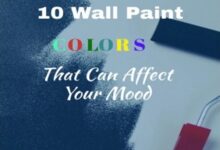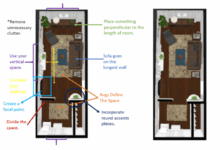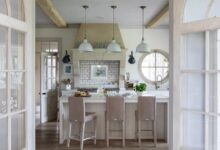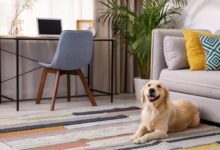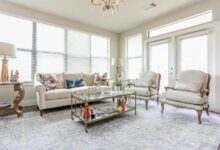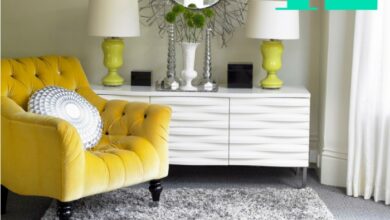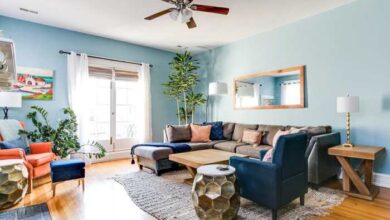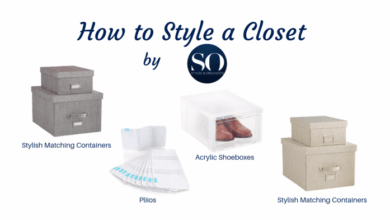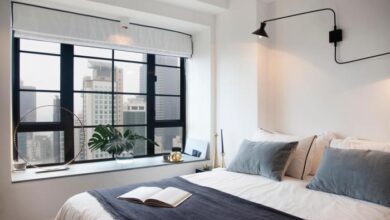Interior Design For Multi-Functional Spaces
Interior Design for Multi-Functional Spaces opens the door to a world where creativity meets practicality, transforming our living and working environments. This approach emphasizes the necessity of designing areas that serve multiple purposes, reflecting a modern lifestyle that values flexibility and efficiency.
As urban living spaces shrink and the demand for versatile areas grows, the need for intelligent design solutions becomes more critical. By focusing on key principles and innovative techniques, we can create spaces that not only look beautiful but also meet the diverse needs of their users.
Importance of Multi-Functional Spaces in Interior Design
The design of multi-functional spaces has become a vital aspect of contemporary interior design, offering innovative solutions to the challenges of modern living. As urban areas grow denser and lifestyles evolve, the need for versatile environments that cater to multiple activities has never been more significant. These spaces not only enhance the functionality of a home but also promote a sense of harmony and balance in everyday life.Creating spaces that serve multiple purposes brings a range of benefits, from maximizing square footage to fostering social interaction.
In an age where flexibility is key, multi-functional spaces allow homeowners to adapt their environments to changing needs. The trends driving this movement are largely influenced by lifestyle changes, technological advancements, and an increasing focus on sustainability. However, the journey to design these adaptable spaces comes with its own set of challenges, including spatial constraints and the need for thoughtful planning.
Benefits of Designing Spaces for Multiple Purposes
Designing multi-functional spaces provides numerous advantages that cater to the diverse needs of occupants. The benefits include:
- Space Optimization: Multi-functional spaces effectively utilize available square footage, making smaller homes feel more expansive. For instance, a living room that converts into a guest bedroom maximizes utility without requiring additional space.
- Cost-Effectiveness: By combining functions, homeowners can save on renovation costs and reduce the need for additional furniture. A dining table that doubles as a workspace is a perfect example of cost efficiency.
- Enhanced Social Interaction: Open-concept layouts encourage interaction between family members and guests. A combined kitchen and dining area fosters a welcoming atmosphere, perfect for gatherings.
- Adaptability: Multi-functional spaces can easily adjust to varied activities, from home offices during the day to entertainment areas in the evening, making them ideal for dynamic lifestyles.
Trends Driving the Need for Multi-Functional Spaces
Several key trends are shaping the demand for multi-functional spaces in interior design. These trends reflect societal shifts and technological innovations that influence how we live and work:
- Remote Work: With the rise of telecommuting, homes are increasingly required to accommodate workspaces. A corner of the living room transformed into an office exemplifies this trend.
- Sustainability: The focus on eco-friendly living encourages designs that prioritize resource efficiency. Multi-functional furniture, such as a sustainable sofa that converts into a bed, aligns with this ethos.
- Urban Living: As more people move to urban areas, smaller living spaces necessitate innovative design solutions. Compact furniture that serves multiple roles is a response to this reality.
- Health and Wellness: Spaces that promote well-being encourage a harmonious blend of functionality and relaxation, such as yoga areas integrated into living rooms.
Challenges Faced in Creating Multi-Functional Spaces
While the benefits of multi-functional spaces are clear, designers face various challenges in their creation. Understanding these obstacles can lead to more effective solutions:
- Spatial Constraints: Limited square footage can make it difficult to incorporate multiple functions without compromising comfort. Careful planning and creative design are essential to address this issue.
- Design Cohesion: Balancing aesthetic appeal with functionality can be challenging. Designers must ensure that all elements work harmoniously together while still serving multiple purposes.
- Storage Solutions: As spaces become more versatile, the need for effective storage increases. Finding innovative ways to hide or integrate storage can be a complex task.
- Personalization: Adapting a space to serve different functions for different family members requires thoughtful consideration of individual needs and preferences.
Key Principles of Design for Multi-Functional Spaces

Source: learnarchitecture.online
Creating a harmonious and efficient environment in multi-functional spaces requires a thoughtful approach to design. By adhering to specific principles, designers can enhance the usability and aesthetic appeal of areas that serve multiple purposes. The key lies in understanding how these principles intertwine with spatial awareness and color selection to create a cohesive atmosphere that is both practical and inviting.
Essential Design Principles for Enhanced Functionality
Effective design for multi-functional spaces centers around several core principles that drive functionality and elevate user experience. These principles include flexibility, modularity, and accessibility.
- Flexibility: Designing spaces that can easily adapt to different activities is crucial. For example, a living room can be transformed into a workspace with the addition of portable desks or movable partitions, allowing users to switch functions as needed.
- Modularity: Utilizing modular furniture allows for easy reconfiguration. Pieces such as sectional sofas or stackable chairs enable quick changes in layout to accommodate gatherings, relaxation, or work.
- Accessibility: Ensuring that all areas of a multi-functional space are easily accessible is vital. This includes considering furniture height, movement space, and storage solutions that are within reach for all users.
Importance of Spatial Awareness in Achieving Balance
Spatial awareness plays a critical role in designing multi-functional spaces. Understanding how different elements interact within a space can help create a balanced environment that feels cohesive rather than cluttered.
A well-balanced space enhances the flow and encourages users to engage with their surroundings.
When designing, consider the following aspects of spatial awareness:
- Proportion: Maintaining appropriate proportions between furniture and room size ensures that the space does not feel cramped or overwhelming.
- Flow: Creating pathways for movement encourages interaction and reduces obstacles, making it easier to transition between different functions.
- Zones: Defining distinct areas for various activities, such as a reading nook or a workspace, helps in organizing the space effectively.
Color Schemes That Facilitate Versatility
The selection of a color palette significantly impacts the versatility of a multi-functional space. Colors can evoke emotions and define areas within a space, making them essential in the design process. A well-chosen color scheme should promote cohesion while allowing for adaptability. Consider these elements when selecting colors:
- Neutral Bases: Utilizing neutral colors as a base creates a calm backdrop that complements other design elements and allows for easy updates with accessories.
- Accent Colors: Incorporating accent colors through accessories like cushions or artwork can inject personality and allow for seasonal changes without a complete redesign.
- Consistency: Consistent color usage throughout the space ties different areas together, creating a seamless transition between functions.
In conclusion, applying these essential design principles, maintaining spatial awareness, and thoughtfully selecting color schemes enables the creation of beautiful, functional, and versatile multi-functional spaces that cater to a variety of needs and lifestyles.
Techniques for Maximizing Space Efficiency
In an era where urban living often means limited square footage, mastering space efficiency becomes a necessity. Multi-functional spaces not only enhance the utility of a home but also create a sense of openness and tranquility. Utilizing innovative techniques can transform any area into a versatile haven that meets varied needs, catering to both functionality and aesthetic appeal.One of the most effective ways to maximize space efficiency is through clever storage solutions.
These innovative ideas can help declutter and organize your space, making it feel larger and more inviting. Consider incorporating vertical storage options, such as shelves that reach the ceiling, to draw the eye upward and create an illusion of height. Furniture with built-in storage, like ottomans that open up for extra blankets or bookshelves that double as room dividers, can be game-changers in compact areas.
Innovative Storage Solutions
Storage solutions play a pivotal role in maintaining order in multi-functional spaces. They not only provide a place for everything but also help in utilizing every inch wisely. Here are some innovative solutions to consider:
- Under-bed storage: Utilize the space beneath beds for storing seasonal clothing or extra linens. Use rolling bins or drawers to make access easy.
- Wall-mounted organizers: Install pegboards or hooks on walls to hold frequently used items like kitchen utensils or children’s toys, keeping them off the floor.
- Hidden compartments: Consider furniture with hidden storage options, such as coffee tables with drawers or benches that lift to reveal storage space.
Furniture that Serves Dual Purposes
Choosing the right furniture can significantly impact the functionality of a space. Dual-purpose furniture not only conserves space but also enhances the versatility of a room. Here are some furniture ideas that serve multiple purposes:
- Convertible sofas: A sofa that converts into a bed is perfect for hosting guests without needing a dedicated guest room.
- Drop-leaf tables: These tables can expand for dining and then collapse to save space when not in use, ideal for small kitchens or dining areas.
- Storage ottomans: These can act as seating or footrests while providing hidden storage for games, blankets, or magazines.
Incorporating Adaptable Layouts
Adaptable layouts allow spaces to evolve and change according to needs, promoting flexibility and comfort. This approach is essential for maximizing space efficiency in multi-functional areas. Here are methods to create adaptable layouts:
- Movable partitions: Use sliding doors or folding screens that can create separate areas for work or relaxation, allowing the space to change quickly.
- Multi-zone lighting: Incorporate different lighting options to set the mood for various activities, from focused work to cozy relaxation.
- Flexible seating arrangements: Choose lightweight chairs that can be easily moved or stacked, allowing for various seating configurations depending on the occasion.
Utilizing these techniques not only enhances the functionality of your space but also fosters creativity in design, making every square foot count.
Case Studies of Successful Multi-Functional Space Designs
In the realm of interior design, multi-functional spaces stand out as an innovative approach to maximizing utility without compromising aesthetics. By blending various functions into a single area, designers not only enhance livability but also create environments that cater to diverse needs. This section explores noteworthy examples of residential, commercial, and public spaces that embody the principles of multi-functionality, demonstrating how effective design can transform spaces into flexible, dynamic environments.
Residential Multi-Functional Designs
One remarkable example of a residential design that effectively uses multi-functional spaces is the “Tiny House” movement. These compact homes maximize every square inch through clever design solutions. For instance, a popular design features a Murphy bed that folds into the wall, liberating floor space during the day. Additionally, built-in furniture serves multiple purposes, such as a dining table that doubles as a workspace.
Key elements of these designs include:
- Foldable furniture that adapts to different activities.
- Open-plan layouts that encourage flexibility and movement.
- Storage solutions that are integrated into walls and under furniture.
Such designs illustrate how thoughtful planning can transform limited spaces into vibrant homes.
Commercial Space Versatility
In the commercial sector, the office design for companies like WeWork exemplifies the principles of versatility. These shared workspaces are designed to accommodate various functions, from quiet working areas to collaborative meeting spaces. Each site features movable partitions, allowing teams to reconfigure the space as needed.Noteworthy characteristics of this approach include:
- Flexible seating arrangements that can be reconfigured for different group sizes.
- Common areas that serve as social hubs and networking spots.
- Technology integration that supports remote work and connectivity.
This design strategy not only fosters collaboration but also encourages creativity within a professional environment.
Public Spaces for Community Use
Public parks and community centers often incorporate multi-functionality to enhance community engagement. For instance, the High Line in New York City serves as both a walking path and a venue for cultural events. This elevated park features seating areas, gardens, and spaces for art installations, creating a vibrant community hub.The design principles observed include:
- Landscapes that can be used for leisure activities, performances, and gatherings.
- Modular installations that can be adapted for various events and activities.
- Accessibility features that ensure all community members can utilize the space.
By integrating nature and urban life, such spaces promote social interaction and foster a sense of community.
“Multi-functional spaces are not just about aesthetics; they are about enhancing the way we live and interact.”
Furniture Choices for Multi-Functional Spaces
In the realm of interior design, selecting the right furniture is pivotal for creating functional and beautiful multi-functional spaces. The ideal furniture not only maximizes utility but also enhances the aesthetic appeal of a room. In this section, we will explore various furniture styles that suit flexible environments, the advantages of modular furniture, and how to choose pieces that align harmoniously with a dual-purpose design.
Furniture Styles for Flexible Environments
When designing multi-functional spaces, it’s essential to consider furniture that adapts to various uses without compromising style. Several furniture styles excel in this regard:
- Modern Scandinavian: Characterized by clean lines, light colors, and minimalist design, Scandinavian furniture often features versatile pieces that can easily transition from one function to another, such as a coffee table that doubles as a storage unit.
- Industrial: With its raw materials and robust construction, industrial-style furniture offers durability and an aesthetic that blends well in urban settings. Items like folding tables and stackable chairs are particularly useful.
- Mid-Century Modern: This style emphasizes functionality through sleek designs and smart use of space. Furniture pieces like credenzas or ottomans with hidden storage are perfect for maintaining organization while adding charm.
- Contemporary: Contemporary furniture often features innovative designs that prioritize usability. Look for sofas that convert into beds or extendable dining tables that cater to both intimate gatherings and larger groups.
Benefits of Modular Furniture in Multi-Functional Settings
Modular furniture has become a favorite in multi-functional spaces due to its adaptability and efficiency. This type of furniture can be rearranged or combined in various configurations to suit different needs, making it perfect for shifting circumstances.
- Versatility: Modular pieces can be easily reconfigured for different activities, whether hosting guests, relaxing, or working from home.
- Space-saving: Many modular designs are compact and can be stacked or stored away when not in use, freeing up valuable floor space.
- Customization: Consumers can choose different modules to create a setup that fits their specific lifestyle, preferences, and spatial constraints.
- Cost-efficiency: By investing in modular furniture, you gain multiple functionalities in one purchase, potentially saving money in the long run.
Aesthetics of Dual-Purpose Furniture Design
Choosing furniture that complements a dual-purpose design is essential for maintaining visual harmony in a multi-functional space. The aesthetics of such furniture should align with the overall design theme while providing practical solutions.The importance of color, material, and shape cannot be overstated. For instance, muted colors can create a calming atmosphere, while bold hues can serve as focal points. The use of materials such as wood, metal, or fabric should resonate with the existing décor, ensuring cohesion throughout the environment.
“Selecting the right furniture is not just about function; it’s about creating an inviting atmosphere that reflects personal style.”
In essence, furniture choices for multi-functional spaces should embrace functionality while enhancing the aesthetic integrity of the environment. By understanding the styles that work best, the benefits of modular designs, and the importance of cohesive aesthetics, one can create spaces that are both beautiful and practical.
Lighting Solutions for Versatile Spaces
Lighting plays a crucial role in interior design, especially in multi-functional spaces where adaptability is key. The right lighting can transform an area, enhancing its functionality and atmosphere while catering to various activities—from work and relaxation to entertaining guests. By understanding and applying effective lighting techniques, you can create versatile environments that elevate both aesthetics and usability.Natural light is an essential element in designing adaptable spaces.
It not only enhances the visual appeal of an area but also contributes to the overall well-being of its inhabitants. Incorporating windows, skylights, and open layouts can maximize daylight exposure, creating a vibrant and inviting atmosphere. Natural light can also redefine the perception of space, making it feel larger and more open, which is particularly beneficial in smaller areas.
Lighting Techniques for Enhanced Functionality
Employing a variety of lighting techniques is vital for maximizing the efficiency and versatility of spaces. Here are several effective strategies:
- Ambient Lighting: This serves as the primary source of illumination in a room, providing general visibility. Ceiling-mounted fixtures, recessed lighting, and wall sconces are excellent options for creating a uniform light level throughout the space.
- Task Lighting: Essential for specific tasks, such as reading or cooking, task lighting focuses illumination where it is most needed. Adjustable desk lamps, under-cabinet lights, and pendant fixtures can enhance functionality in designated areas.
- Accent Lighting: Used to highlight architectural features, artwork, or plants, accent lighting adds depth and dimension to an environment. Spotlights and track lights are effective in drawing attention to focal points.
- Decorative Lighting: Combining form and function, decorative lighting fixtures like chandeliers or artistic lamps not only illuminate but also serve as statement pieces, contributing to the overall aesthetics of the space.
Layering these lighting types allows for versatility, enabling the space to transition seamlessly between different uses. For example, a living room can shift from a bright, functional workspace during the day to a warm, inviting setting for social gatherings in the evening simply by adjusting the lighting layers.
Natural Light Strategies
Incorporating natural light into a design can dramatically enhance a space’s adaptability. Here are some strategies to consider:
- Window Placement: Strategically placing windows can maximize daylight. Consider larger windows or floor-to-ceiling designs that open up a room to the outside.
- Transom Windows: These small windows above doorways can provide additional light without sacrificing privacy, making them a great option for interior spaces.
- Mirrors: Using mirrors strategically can reflect natural light throughout the room, making it feel brighter and more spacious.
- Open Floor Plans: Creating an open layout allows light to flow freely between spaces, eliminating dark corners and enhancing the overall brightness.
Natural light not only reduces the need for artificial lighting but also creates a dynamic atmosphere that changes with the time of day, allowing the space to feel alive and ever-changing.
Layering Lighting for Multiple Purposes
Layering lighting effectively caters to multiple functions within a space. Here are some tips to achieve an ideal balance:
- Dimmer Switches: Installing dimmer switches allows for greater control over brightness levels, enabling you to adjust the light based on the time of day or the occasion.
- Smart Lighting: Utilizing smart bulbs or systems that can be programmed or controlled via smartphone allows for customizable lighting schemes tailored to different activities.
- Flexible Fixtures: Choosing fixtures that can be repositioned or adjusted, such as floor lamps or adjustable wall sconces, provides the flexibility needed for changing space requirements.
- Color Temperature Adjustment: Selecting bulbs with adjustable color temperatures can shift the ambiance from cool and energizing to warm and cozy, depending on the desired mood.
By thoughtfully layering lighting solutions, you can create a cohesive environment that accommodates a variety of functions and enhances the overall experience of the space.
Creating Zones in Multi-Functional Spaces
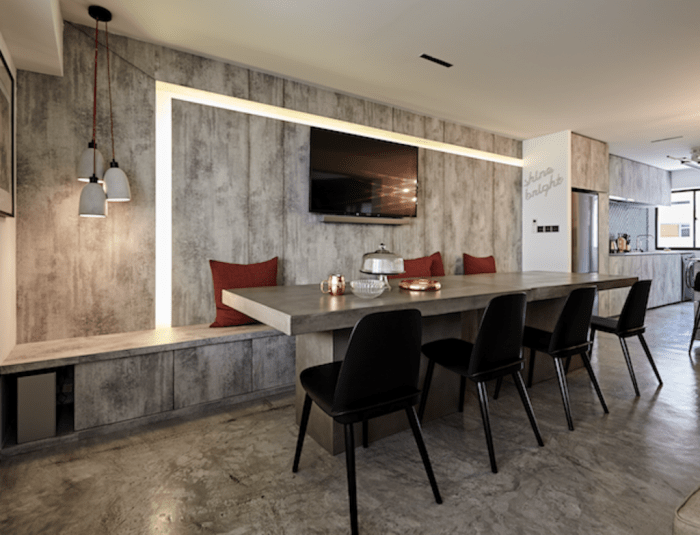
Source: asiaone.com
In the dynamic world of interior design, creating distinct zones within multi-functional spaces is essential for both aesthetic appeal and practical use. These zones allow for a seamless transition between different activities, fostering a sense of harmony while enhancing functionality. By thoughtfully separating areas, you can transform a single room into several unique yet interconnected environments.Visually separating areas within a single space can be achieved through various techniques, which not only create boundaries but also enhance the overall design.
One effective method is the use of decorative elements, which serve to define distinct zones while adding character to the space. Incorporating various materials, textures, and colors can significantly impact the perception of different areas.
Use of Partitions and Furniture Arrangements
Partitions and thoughtful furniture arrangements play a crucial role in delineating spaces and establishing a sense of order. Here are several effective methods to create boundaries within multi-functional spaces:
- Use of Screens: Folding screens or room dividers can create instant privacy and visual separation without the permanence of walls. They can be easily moved or reconfigured as needed, making them a versatile choice for dynamic spaces.
- Furniture Groupings: Arranging furniture in clusters can naturally define areas. For instance, placing a sofa facing a coffee table creates a living area, while a desk paired with a chair forms a workspace.
- Rugs as Boundaries: Area rugs are a powerful tool for visually anchoring different zones. A well-placed rug can delineate a dining area from a living space, offering both comfort and style.
- Color and Material Variation: Utilizing different paint colors or materials on the walls or flooring can signify transitions between zones. For example, a change from hardwood to tile can indicate the start of a kitchen area.
- Built-In Shelving: Open shelving can act as a partition while also offering storage solutions. It allows light to flow through while providing a subtle separation between areas.
By implementing these strategies, you can create functional zones that enhance the usability of a space while reflecting your personal style. These design elements not only clarify the purpose of each area but also foster an inviting atmosphere that caters to various activities.
Sustainability Considerations in Multi-Functional Design
In today’s world, the importance of sustainability in interior design cannot be overstated. As we strive to create spaces that serve multiple purposes, it is essential to embrace eco-friendly practices and materials. This approach not only benefits the environment but also enhances the quality of life for those who inhabit these spaces.The use of sustainable materials and energy-efficient designs plays a crucial role in making multi-functional spaces environmentally responsible.
By selecting materials that are not only versatile but also eco-friendly, designers can create interiors that meet the needs of modern living without compromising the planet’s health.
Eco-Friendly Materials for Versatile Spaces
Choosing the right materials is fundamental to achieving a sustainable multi-functional design. Various eco-friendly options are available that are both aesthetically pleasing and functional. Some commonly used materials include:
- Bamboo: A rapidly renewable resource, bamboo is strong, lightweight, and can be used for flooring, furniture, and decorative elements.
- Reclaimed Wood: Utilizing wood from old structures or furniture reduces the demand for new timber while adding character and history to spaces.
- Recycled Metal: Metals like aluminum and steel can be recycled infinitely without losing quality, making them ideal for furniture and fixtures.
- Low-VOC Paints: These paints minimize harmful emissions, ensuring healthier indoor air quality while providing a fresh look.
Using these materials not only minimizes environmental impact but also promotes a healthier lifestyle.
Energy-Efficient Designs That Enhance Multi-Functionality
Integrating energy-efficient designs is key to maximizing the functionality of multi-purpose spaces. Effective strategies include:
- Natural Lighting: Strategically placed windows and skylights can reduce the need for artificial lighting during the day, enhancing the ambiance while saving energy.
- Insulation: Proper insulation helps maintain comfortable temperatures throughout the year, reducing heating and cooling costs.
- Energy-Efficient Appliances: Incorporating appliances with high energy ratings ensures that multi-functional kitchens or workspaces operate efficiently.
- Smart Home Technologies: Utilizing smart thermostats and lighting controls allows users to manage energy consumption effectively.
These energy-efficient designs contribute to a sustainable lifestyle while ensuring that spaces remain adaptable and comfortable.
Sustainable Practices in Multi-Functional Designs
Incorporating sustainable practices into multi-functional designs is vital for long-term viability. Some effective methods include:
- Modular Furniture: Furniture that can be reconfigured or expanded according to need supports flexibility and adaptability.
- Upcycling: Transforming old or unused items into new pieces can add unique character while reducing waste.
- Local Sourcing: Choosing locally sourced materials and products reduces transportation emissions and supports the local economy.
- Water Conservation: Implementing fixtures that conserve water, such as low-flow faucets and dual-flush toilets, contributes to overall sustainability.
By integrating these practices, designers can create spaces that not only serve multiple functions but also promote environmental stewardship and social responsibility.
Future Trends in Multi-Functional Interior Design

Source: designnica.com
As we look toward the future, the landscape of multi-functional interior design is evolving rapidly. The need for spaces that adapt to our changing lifestyles is more pronounced than ever. With urbanization and the rise of remote working, the design of our interiors must reflect versatility and practicality while still offering aesthetic appeal. Predicting the evolution of these spaces involves not only analyzing current trends but also anticipating future needs and technological advancements.The impact of technology on multi-functional spaces is profound.
Smart home technology is paving the way for new levels of versatility. As devices become increasingly interconnected, rooms can serve multiple functions seamlessly. For instance, with the use of smart furniture that can transform for various uses—from a desk that folds away to create more living space to a sofa that converts into a bed—interior design is becoming more fluid and functional.
The infusion of technology creates spaces that adapt based on the time of day, your activities, or even your mood.
Technological Innovations Enhancing Versatility
Innovations in technology are at the forefront of transforming multi-functional spaces. The integration of smart home systems allows for a dynamic interaction between occupants and their environments. Key advancements include:
- Modular Furniture: Pieces that can be reconfigured for different uses, such as sectional sofas that can be rearranged or expanded based on the occasion.
- Smart Walls: Walls equipped with screens or interactive panels that can serve as displays, workstations, or even communication hubs.
- Mobile Applications: Apps that control lighting, climate, and even furniture arrangements, allowing users to customize their spaces effortlessly.
The future of interior design also embraces emerging design philosophies that prioritize sustainability and community. As consumers become more environmentally conscious, designs that support eco-friendly materials and energy-efficient practices are gaining traction. Multi-functional spaces can play a significant role in reducing waste and conserving resources. For example, using reclaimed materials for furniture or incorporating plants that improve indoor air quality reflects a commitment to both design and the environment.
Sustainable Practices in Multi-Functional Design
Sustainability in multi-functional design emphasizes the importance of utilizing resources wisely. This involves integrating components that reduce environmental impact while enhancing the functionality of spaces. Key practices include:
- Adaptive Reuse: Repurposing existing structures to meet modern needs without the need for new materials.
- Energy-Efficient Systems: Installing solar panels and energy-efficient appliances to minimize utility costs and environmental footprints.
- Biophilic Design: Incorporating natural elements into interiors to promote well-being and connect inhabitants to nature.
By embracing these future trends, designers can create spaces that are not only functional but also responsive to the needs of their users—ensuring that multi-functional interior design remains relevant and enriching in the years to come.
Wrap-Up
In summary, embracing multi-functional design can significantly enhance our spaces’ usability and aesthetic appeal. By understanding the principles, techniques, and future trends, we can create environments that adapt to our lives, making every square foot count and enriching our daily experiences.
FAQ Summary
What are multi-functional spaces?
Multi-functional spaces are areas designed to serve more than one purpose, allowing for flexibility in use, such as combining living, working, and recreational activities.
How can I make my small space multi-functional?
Utilize space-saving furniture, incorporate hidden storage solutions, and create adaptable layouts to maximize your small area’s functionality.
What types of furniture are best for multi-functional designs?
Modular furniture, foldable tables, and convertible sofas work best as they can easily adapt to different needs and settings.
Can lighting affect the functionality of multi-functional spaces?
Yes, appropriate lighting techniques can enhance visibility and mood, making spaces more usable for various activities throughout the day.
How do I define zones in a multi-functional space?
You can use rugs, furniture arrangements, or decorative elements to visually separate areas within a single space, helping to create distinct zones.
What are some sustainable practices for multi-functional design?
Incorporating eco-friendly materials, energy-efficient designs, and sustainable furniture choices can contribute to a more environmentally responsible multi-functional space.
What future trends should we look out for in multi-functional spaces?
Expect to see advancements in technology that enhance adaptability, along with emerging design philosophies focusing on minimalism and multi-use functionality.
